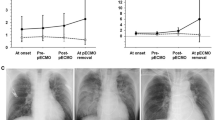Abstract
Fulminant myocarditis is a rapidly progressive, life-threatening disease with severe impairment of systolic left ventricle function in the acute phase. However, the long-term prognosis of patients who survive the acute phase with percutaneous extracorporeal cardiopulmonary support (PCPS) is not established. The purpose of this study was to elucidate the long-term follow-up on chronic cardiac function and long-term outcome. Twenty consecutive patients with fulminant myocarditis in the acute phase supported by PCPS were enrolled between January 1995 and March 2010. Echocardiography was performed at least three times; acute phase (within 3 days from onset), predischarge (days 3–30), and chronic phase (>6 months, 2.67 ± 2.19 years, mean ± SD). The clinical events were queried by their medical record and questionnaires. Eight patients (40%) died in the acute phase. The time course of ejection fraction (%) by echocardiography was 22.7 ± 9.8, 53.1 ± 7.2, and 57.2 ± 9.6 in acute, predischarge, and chronic phase, respectively. Diastolic dimension (mm) was 46.8 ± 7.4, 51.3 ± 2.9, and 50.4 ± 1.8, and systolic dimension (mm) was 41.4 ± 7.7, 36.8 ± 4.0, and 35.2 ± 3.3 in acute, predischarge, and chronic phase, respectively. There was no recurrence or admission related to heart failure during the follow-up period. The cardiac function of patients with fulminant myocarditis recovers rapidly during their stay in hospital. The cardiac function of predischarge patients remains unchanged in the chronic phase. The long-term survival of fulminant myocarditis appears favorable in the chronic phase.


Similar content being viewed by others
References
Lieberman EB, Hutchins GM, Herskowitz A, Rose NR, Baughman KL (1991) Clinicopathologic description of myocarditis. J Am Coll Cardiol 18(7):1617–1626
Cooper LT Jr (2009) Myocarditis. N Engl J Med 360(15):1526–1538
Acker MA (2001) Mechanical circulatory support for patients with acute-fulminant myocarditis. Ann Thorac Surg 71(3 Suppl):S73–76 (discussion S82–85)
Maejima Y, Yasu T, Kubo N, Kawahito K, Omura N, Katsuki T, Tsukamoto Y, Sugawara Y, Hashimoto S, Tsuruya Y, Hirahara T, Takagi Y, Kobayashi N, Funayama H, Ikeda N, Ishida T, Fujii M, Ino T, Saito M (2004) Long-term prognosis of fulminant myocarditis rescued by percutaneous cardiopulmonary support device. Circ J 68(9):829–833
Chen YS, Yu HY (2005) Choice of mechanical support for fulminant myocarditis: ECMO vs. VAD? Eur J Cardiothorac Surg 27(5):931–932 (author reply 932)
Unosawa S, Hata M, Sezai A, Niino T, Yoshitake I, Shimura K, Takamori T, Minami K (2010) Successful management of fulminant myocarditis with left ventricular assist device: report of a severe case. Ann Thorac Cardiovasc Surg 16(1):48–51
Yasu T, Murata S, Katsuki T, Fujii M, Kubo N, Ohmura N, Ino T, Saito M (1997) Acutely severe myocarditis successfully treated by percutaneous cardiopulmonary support applied by a newly developed heparin-binding oxygenator and circuits. Jpn Circ J 61(12):1037–1042
Kawahito K, Murata S, Yasu T, Adachi H, Ino T, Saito M, Misawa Y, Fuse K, Shimada K (1998) Usefulness of extracorporeal membrane oxygenation for treatment of fulminant myocarditis and circulatory collapse. Am J Cardiol 82(7):910–911
Aoyama N, Izumi T, Hiramori K, Isobe M, Kawana M, Hiroe M, Hishida H, Kitaura Y, Imaizumi T (2002) National survey of fulminant myocarditis in Japan: therapeutic guidelines and long-term prognosis of using percutaneous cardiopulmonary support for fulminant myocarditis (special report from a scientific committee). Circ J 66(2):133–144
Hare JM, Baughman KL (2001) Fulminant and acute lymphocytic myocarditis: the prognostic value of clinicopathological classification. Eur Heart J 22(4):269–270
Amabile N, Fraisse A, Bouvenot J, Chetaille P, Ovaert C (2006) Outcome of acute fulminant myocarditis in children. Heart 92(9):1269–1273
Felker GM, Boehmer JP, Hruban RH, Hutchins GM, Kasper EK, Baughman KL, Hare JM (2000) Echocardiographic findings in fulminant and acute myocarditis. J Am Coll Cardiol 36(1):227–232
Asaumi Y, Yasuda S, Morii I, Kakuchi H, Otsuka Y, Kawamura A, Sasako Y, Nakatani T, Nonogi H, Miyazaki S (2005) Favourable clinical outcome in patients with cardiogenic shock due to fulminant myocarditis supported by percutaneous extracorporeal membrane oxygenation. Eur Heart J 26(20):2185–2192
McCarthy RE 3rd, Boehmer JP, Hruban RH, Hutchins GM, Kasper EK, Hare JM, Baughman KL (2000) Long-term outcome of fulminant myocarditis as compared with acute (nonfulminant) myocarditis. N Engl J Med 342(10):690–695
Caforio AL, Calabrese F, Angelini A, Tona F, Vinci A, Bottaro S, Ramondo A, Carturan E, Iliceto S, Thiene G, Daliento L (2007) A prospective study of biopsy-proven myocarditis: prognostic relevance of clinical and aetiopathogenetic features at diagnosis. Eur Heart J 28(11):1326–1333
Wang Y, Shimada M, Xu Y, Hu D, Nishio R, Matsumori A (2010) Role of substance P in viral myocarditis in mice. Heart Vessels 25(4):348–352
Kamal FA, Watanabe K, Ma M, Abe Y, Elbarbary R, Kodama M, Aizawa Y (2011) A novel phenylpyridazinone, T-3999, reduces the progression of autoimmune myocarditis to dilated cardiomyopathy. Heart Vessels 26(1):81–90
Lee CH, Tsai WC, Hsu CH, Liu PY, Lin LJ, Chen JH (2006) Predictive factors of a fulminant course in acute myocarditis. Int J Cardiol 109(1):142–145
Acknowledgment
The authors thank Yuki Hayakawa B.S., Hiroaki Kotsuka B.S., and Norio Yufune B.S. for their excellent work with echocardiography.
Conflict of interest
None.
Author information
Authors and Affiliations
Corresponding author
Rights and permissions
About this article
Cite this article
Ishida, K., Wada, H., Sakakura, K. et al. Long-term follow-up on cardiac function following fulminant myocarditis requiring percutaneous extracorporeal cardiopulmonary support. Heart Vessels 28, 86–90 (2013). https://doi.org/10.1007/s00380-011-0211-8
Received:
Accepted:
Published:
Issue Date:
DOI: https://doi.org/10.1007/s00380-011-0211-8




